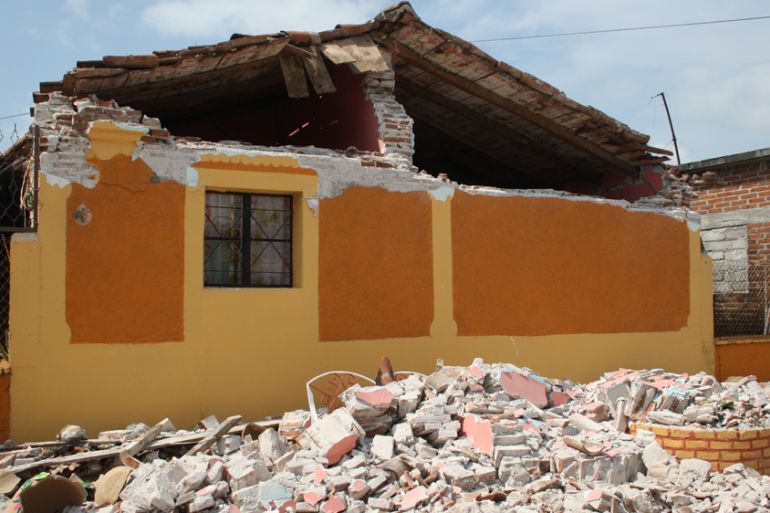Mexico earthquake: Victims complain of slow response
As death toll climbs to 90, residents of town hit by the 8.1-temblor say authorities reacted too slowly to their plight.

Asuncion Ixtaltepec, Mexico – Public safety director Jersey Rios drove around this southern town with police officers to assess the damage caused by the deadly 8.1-magnitude quake – the most powerful to hit the country in 85 years.
Between 14,000 and 16,000 people live here, but only a team of 11 policemen can assist the town.
Keep reading
list of 4 itemsHow is Afghanistan coping six months after deadly quakes?
‘Violent rumble’: 4.8 magnitude earthquake rattles New York City, northeast
Taiwan searches for 18 still missing after Wednesday’s earthquake
“Nobody has come to offer us help. It’s a miracle we’re alive,” resident Julian Gomez told Al Jazeera.
Gomez was on the second floor of his house with his wife and seven-year-old daughter when the first tremors were felt just before midnight. The family was about to run down the stairs to exit the house, but his wife suddenly froze. In a split second, the house collapsed, and they landed on the first floor with no injuries – not even a scratch.
“It’s good that she froze otherwise …” Gomez says, silencing himself. “We’re going to move to our father-in-law’s house; we lost everything.”
READ MORE: Death toll in Mexico’s biggest quake continues to rise
Driving around the shattered town with Rios, it feels like a war zone with houses fully collapsed, many others about to, and those still standing showing visible structural damage. Some of the roads are blocked because of funeral processions, while residents cordon off streets to prevent further collapses from the vibration of moving vehicles.
Residents were also forced to provide relief efforts right after the quake with neighbours teaming up to help people buried under the rubble.
|
|
“My husband and other neighbours had to rescue the teacher that lived there,” says Jane Wong Morales, pointing at a pile of rubble in front of her house. “He died trying to save his son and wife.”
At least 90 people were killed by the temblor throughout Mexico, and the number continues to climb.
There is still no official death toll confirmed here, but Rios estimates that at least 10 people have died. He says the first action is to help people with funeral services since the closest funerary is in Juchitan, a city 10km away where the majority of relief efforts and political attention are concentrated.
“We have been bringing coffins from Juchitan to bury the people,” Rios says.
Before noon on Saturday, Alejandro Murat, governor of Oaxaca, arrived in Ixtaltepec to visit the families. Along with him came long-awaited help, almost 36 hours after the quake struck.
![Police cordon off a street after the quake struck in the small town of Asuncion Ixtaltepec [Chantal Flores/Al Jazeera]](/wp-content/uploads/2017/09/9ec8f9af263e42f087756e1cebf8f57d_18.jpeg)
State police and the military arrived to implement the emergency plan DN-III involving using search and rescue dogs to locate missing people and rubbish removal efforts. Residents received them with loud complaints, having spent the first 24 hours with no shelter or immediate access to medical care.
“There were dead people, and nobody came,” a neighbour yelled at Rios while his team tried to unblock some of the streets for the governor and his entourage.
Adriana Cabrera, president of National System for Integral Family Development, had to improvise a shelter in a building that used to be a high school. At least 500 people were going to the shelter every day for food, which was donated by Mexicans from other areas in Oaxaca or neighbouring states since there is no running water or electricity.
“We have not yet received any support from the state or federal authorities,” Cabrera told Al Jazeera.
READ MORE: Magnitude-8.1 earthquake strikes off southern Mexico
The state government issued a statement right after the visit, but it omitted the death toll and affirmed it was a priority to provide immediate attention. Murat told Al Jazeera the main priority was to provide shelter and food.
The second phase carried out by the state civil protection authority will be to visit each house to assess damage. In the meantime, residents are sleeping on their patios or in the streets outside their houses, refusing to leave them since they fear looting.
Residents complained that the authorities that have visited so far only took photos and compiled information about the inhabitants of the homes.
![Residents of Asuncion Ixtaltepec have complained about the slow response by authorities [Chantal Flores/Al Jazeera]](/wp-content/uploads/2017/09/299fcb6bffb4419baec27cdf8e55ef58_18.jpeg)
Unlike Mexico City, where after the 1985 earthquake development has focused on earthquake-resistant buildings, Oaxaca and other coastal states in the same seismic zone have received little or no prevention efforts, even though the damage is usually more significant than in the capital because of their proximity to the epicentres.
A member of the military, who declined to give his name, said the first step was to evaluate the situation. But for residents time is crucial.
More than 700 aftershocks have been felt. On Saturday night, a 5.6-magnitude tremor shook already stressed out residents.
Despite being in an active seismic zone, nobody was prepared for this.
“We are used to flooding,” says Rios. “That we can prevent, but this – it’s impossible.”
![Oaxaca's governor, Alejandro Murat, talks to affected families [Chantal Flores/Al Jazeera]](/wp-content/uploads/2017/09/9db0d47a75a840f3970b9b7ad6cf815d_18.jpeg)